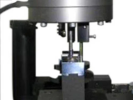In Vitro Microindentation of Bone to Determine Mechanical Properties
Microindentation testing allows for the measurement of mechanical properties of bone and other hard tissues, and it is vital for estimating the stresses and strains exerted at the cellular level that are caused by loadings experienced on a macro-scale. Microindentation testing helps researchers understand the intrinsic properties of bone that cannot be measured in experiments using larger bone specimens.
The objective of this particular microindentation test is to determine loading and unloading modulus during the indent. For a successful test, it is imperative to measure indentation depth relative to the surface of the specimen of bone, as well as accurately measure the force applied during the indent.
Our microindentation head can be mounted to a 5948 MicroTester system or an ElectroPuls™ E1000 Dynamic Test Instrument. The head features the ability to measure forces with a resolution of less than 10 mN and an indentation depth with a resolution of less than 10 nm.
The microindentation head can be removed from the system to leave a test machine that is capable of other tensile, compression, or flexure tests. In the case of ElectroPuls, it can perform fatigue tests on a variety of biomaterials or medical devices.

